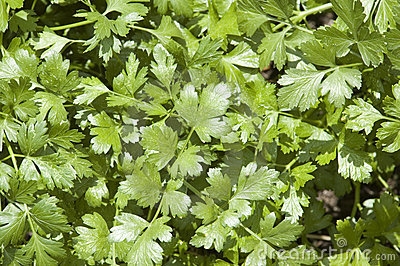From the UC Cooperative Extension Monterey County Crop Notes newsletter (March/April 2014)

In the last two years, two significant herbicide registrations have brought excellent weed control options to these crops: prometryn (Caparol, Syngenta and other companies) and linuron (Lorox, TKI NovaSource).Both of these registrations were new for cilantro, but Caparol was already registered on parsley and Lorox was a new registration for parsley. Both registrations came with restrictions: Prometryn has a12-month plant back to lettuce and spinach which is a difficult obstacle for Salinas Valley producers. The registration for linuron currently only has a Federal label, but the California registration is in process and hopefully will be completed before the end of the year.
Prefar is also registered for use on cilantro and parsley but due to a regulatory snafu (EPA moved cilantro out of the “leafy vegetables” crop group and placed it in the “herbs and spices” crop group), which resulted in the loss of the Prefar tolerance, by cilantro. It is unclear how long it will take to resolve this issue, but again it is in the process for reestablishment of the tolerance, but that may take time.
We conducted weed evaluations of these herbicides in 2012 and 2013. In the 2012 trial on cilantro preemergent applications of both Caparol and Lorox were safer than postemergent applications (Tables1&2) as indicated by the phytotoxicity ratings. Lorox was less phytotoxic than Caparol as a postemergent application. Postemergent applications of both Caparol and Lorox were more effective in reducing weedsand weeding time, but reduced the yield of cilantro and parley relative to preemergent applications. Prefardid not control nightshade in either trial and had greater weeding times as a result.
Other weed control options: bed fumigation of cilantro and parsley prior to planting can be highly effective, but issues with the cost and working around buffer zones makes this option difficult to fi t into a grower's production budget as well as schedule. Cultural practices such as pregermination followed by shallow cultivation of emerged weeds prior to planting can help reduce weed pressure. Cilantro and parsley seed germinates slowly which opens the possibility of burning off a flush of weeds (with an herbicide or propane flamer) following planting but prior to the emergence of the cilantro. This is a tricky, but highly effective technique for reducing weed density.
Table 1. 2102 Cilantro Trial: Weed counts (3 ft2), phytotoxicity rating and time of weeding evaluations of all treatments on September 4 and yield on September 11/p>
1 – scale: 0=no crop damage to 10=crop dead
Table 2. 2013 Parsley Trial: Phytotoxicity, weed counts (50 ft2) and yield on March 25.
1 – scale: 0 = no crop damage to 10 crop dead; 2 – new low VOC formulation of bensulide (Prefar); 3 –standard treatment

